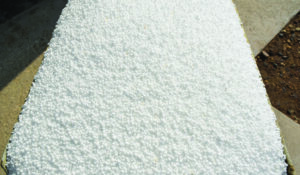Aim to synchronize nitrogen supply with crop demand
KEY RESULT:
Primary targets for emissions reductions in Western Canada should be the controls on emissions occurring at spring thaw and enhanced synchronization of nitrogen supply with crop nitrogen demand.
PROJECT TITLE, PRINCIPAL INVESTIGATORS:
“Balancing agronomic and environmental outcomes using enhanced efficiency nitrogen fertilizers,” Richard Farrell and Kate Congreves, University of Saskatchewan.
FUNDING:
SaskCanola, Saskatchewan Agriculture Development Fund
PUBLISHED ARTICLES:
Read the full report in the Research section at saskcanola.com.
With the cost of synthetic nitrogen fertilizer increasing and the emergence of lower cost enhanced efficiency fertilizer (EEF) technologies, producers are increasingly looking towards technologies that can protect their fertilizer investment while improving both their agronomic and environmental performance. Previous research has shown that substantial reductions in N2O emissions are achievable by combining EEFs with more advanced, 4R-based nitrogen management practices. (Practices that involve applying N fertilizer using the Right source at the Right rate, Right time, and with the Right placement.)
This three-year study over two field seasons evaluated and compared the performance of SuperU (urea treated with dual urease and nitrification inhibitors) and eNtrench (urea treated with a nitrification inhibitor) with that of conventional granular urea in both fall and spring applications. Researchers quantified and compared crop nitrogen uptake, nitrogen use efficiency, canola yield and N2O emissions for all treatments. Yield-scaled N2O emission factors were also calculated for each fertilizer type and application timing to determine the combination that optimized the balance between agronomic and environmental outcomes.
Field trials were conducted at the University of Saskatchewan on plots that had been previously cropped to barley. The fertilizer treatments were applied in the fall or spring and at 70 per cent and 100 per cent of soil test recommendation. The study included a non-fertilized check plot to quantify background emissions and calculate fertilizer-induced emissions. Researchers broadcast each treatment by hand in the late fall after soil temperatures had fallen below 7°C for five consecutive days, or at planting the following spring. They incorporated fertilizer to a depth of about 10 cm immediately after surface application. They seeded plots to hybrid canola in the spring.

Results
Drought conditions during the two growing seasons significantly impacted results of this study, with yields about 30 per cent and 90 per cent lower than target yields in 2020 and 2021, respectively. Overall, the study showed that under these conditions the EEFs had no effect on either yield or nitrogen use efficiency. Generally, the fertilizer rate effects were not significant.
Results of the daily N2O emissions showed that major emission events coincided with snowmelt and spring thaw and the spring seeding and fertilizer operations. For fall nitrogen application, the magnitude of emissions during the spring thaw was determined by environmental and soil conditions both during the overwinter period and at spring thaw. Cumulative spring thaw emissions, which were much greater in 2020 than in 2021, were generally greater with fall nitrogen applications than those associated with the spring nitrogen applications. This reflects the differences in both soil and environmental conditions and available nitrogen supply.
Although severely impacted by moisture deficiencies in both years, the study provided new data on the performance of two common EEF products. However, the results are not reflective of what producers might expect in a “normal” year. Overall, the results provided strong evidence that the primary targets for emissions reductions in Western Canada should be the controls on emissions occurring at spring thaw and enhanced synchronization of nitrogen supply with crop nitrogen demand. Future research should also target nitrogen management strategies that improve synchronization of nitrogen supply with crop demand. This could include detailed studies of N uptake and N losses (including N2O emissions) performed under varying soil and environmental conditions.





